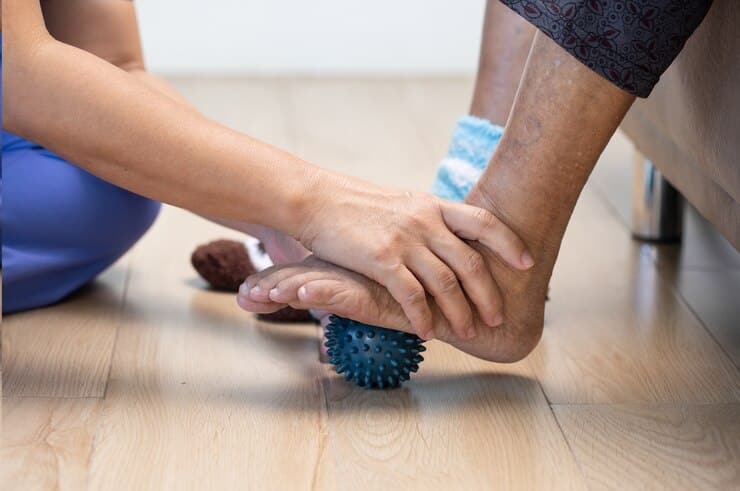Physical therapy (PT) is a great help for people fighting long-term health issues like cancer, diabetes, cardiovascular disease, arthritis, and chronic obstructive pulmonary disease (COPD). It involves making exercise programs that are right for you, teaching about your health, and using supportive therapies. These efforts can make life better for those with ongoing health problems. PT boosts your strength, helps fight tiredness, and improves how flexible you are. It also cuts down on pain, supports during treatment, and can help you do things you could not before.
PT is key in keeping blood sugar levels in check, helping with weight, making your breathing better, and easing joint pain from chronic conditions. With a wide approach, physical therapy shows people how to tackle their health issues and live a more active life. This can lead to a more enjoyable lifestyle.
Key Takeaways : Physical Therapy For Chronic Health
- Physical therapy is a key part of dealing with many chronic health problems.
- Physical therapists make exercise plans to boost your power, energy, and movement.
- PT lowers pain, tiredness, and deals with health issues that come from treatments in many chronic illnesses.
- Physical therapy is essential for easing symptoms and raising your life’s quality.
- A full-on approach to PT gives people abilities to handle their long-term health challenges better.
Understanding Chronic Health Conditions
Chronic diseases are conditions that last a long time and get worse slowly. They need regular medical care. These diseases include cancer, diabetes, heart disease, arthritis, and COPD. More than 1 in 5 adults in the U.S. feel chronic pain almost every day.
Defining Chronic Diseases
Chronic diseases are long-term and can be severe. They need ongoing care. These health problems affect how people live, work, and feel. They can limit what you can do each day.
Prevalence and Impact of Chronic Illnesses
Many people in the U.S. have chronic diseases. These can cause physical, emotional, and financial problems. They make it hard to live independently. The effects go beyond just the person, impacting their family and community too.
Challenges of Living with Chronic Conditions
Living with such an illness is tough. It involves dealing with symptoms, sticking to treatments, and managing stress. It’s important to tackle these challenges with medical care, lifestyle changes, and support. This helps people live their best life despite the illness.
The Role of Physical Therapy in Chronic Disease Management

Physical therapy is key in handling chronic diseases. It focuses on movement and helping people get better. PT experts create special workouts to boost strength, make you more flexible, and last longer. This can make life better, lower tiredness, deal with pain, and lessen drug side effects.
Benefits of Physical Therapy for Chronic Conditions
These special workouts can also help control sugar in your blood and keep your weight in check. They make your lungs and heart stronger too. Besides workouts, physical therapists teach lifestyle changes. This includes eating better and quitting smoking. Such changes help lower the danger of health problems.
Personalized Exercise Programs
Physical therapists don’t use one-size-fits-all plans. They tailor workouts to improve your life, lower fatigue, and ease pain. These programs also help with blood sugar, weight, and breathing. By making workouts just for you, PT is truly effective in managing many chronic illnesses.
Lifestyle Modifications and Education
Learning how to live healthier is also part of the therapy. Physical therapists teach you to eat right and quit smoking. This comprehensive approach helps a lot. It lessens symptoms, makes you more active, and boosts your health all around.
Physical Therapy For Chronic Health

Physical therapy is key for people with chronic health conditions. Physical therapists use movement, rehab, and teaching to help. They aid in managing cancer, diabetes, cardiovascular disease, arthritis, and chronic obstructive pulmonary disease (COPD).
They create personalized exercise programs and lifestyle changes. This improves the quality of life for those dealing with chronic illnesses.
Physical therapy strengthens and boosts flexibility. It helps handle pain and tiredness. This lets patients control their symptoms, improve their functioning, and lead an active life.
With physical therapists, patients get the tailored help they need. This helps manage symptoms and boosts their well-being. They can lead a more active, independent life.
Cancer and Physical Therapy
Physical therapy is very helpful for those fighting cancer. Both the disease and its treatments can weaken and tire patients. Therapists create exercise programs specifically for them. These programs boost strength, endurance, and flexibility. This helps cancer patients feel better and enjoy life more.
Improving Quality of Life
These workouts cut down on cancer-related fatigue and handle pain. They also make treatment side effects less severe. Physical therapy is key in improving the day-to-day life of cancer patients. It makes it easier for them to do regular activities without much trouble.
Managing Treatment Side Effects
Physical therapists don’t only focus on exercise. They also offer education and support. This helps patients deal with treatment side effects better. They teach ways to ease nausea, lymphedema, and other physical limits. These problems often come with chemotherapy and other treatments.
Regaining Functional Abilities
Physical therapy is crucial after surgeries like mastectomy or reconstruction. It helps patients get back to normal activities easier and by themselves. With the therapist’s help, cancer patients can improve their health. This empowers them to recover fully and live their best life again.
Physical Therapy for Diabetes

Physical therapy is key in managing diabetes. Professionals can lead patients in exercises to control blood sugar and boost insulin response. This also helps in managing weight, lowering diabetes risks.
Controlling Blood Sugar Levels
Adding physical activity and lifestyle changes improves diabetes management. Under the guidance of physical therapy, patients can better their health. Exercises prescribed by PTs can adjust blood sugar levels and insulin sensitivity, providing more glucose control.
Weight Management
Physical therapy is crucial for managing weight in diabetes. Custom exercise plans can get patients to a healthy weight. This lowers complications, like heart disease and nerve damage.
Foot Care and Balance Training
Physical therapists teach about foot care and balancing. This is vital for those with diabetes who can get foot ulcers and nerve problems. Adding these to the program improves physical health, lessens falls, and keeps independence.
Cardiovascular Disease and Physical Therapy
Physical therapy is key in dealing with heart and blood vessel issues, which hurt the heart’s function. PT experts tailor exercise plans to boost cardiovascular health. They increase stamina and lower high blood pressure safely.
Cardiac Rehabilitation
PT plays a big role in cardiac rehab for those with cardiovascular disease or heart issues. Therapists guide patients through exercises to get their strength back. This helps improve heart health and lowers the chance of future problems.
Improving Heart Health
Adding regular exercise to daily life helps people with cardiovascular conditions feel better. With PT’s help, therapists create exercises to make the heart stronger, build endurance, and elevate heart health.
Risk Factor Reduction
PT also looks at changing habits like eating better and quitting smoking to cut cardiovascular disease risk. By dealing with things that can change, PT lets patients play a big part in handling their chronic disease better long-term.
Arthritis Management with Physical Therapy

Physical therapy uses many methods to ease arthritis symptoms and improve joint movement. Physical therapists help a lot by using their knowledge, especially with physical therapy for arthritis and arthritis and physical therapy.
Reducing Joint Pain and Stiffness
They employ exercises, manual therapy, and treatments like heat or cold therapy to cut joint pain and ease joint stiffness. These actions also aim to make surrounding muscles stronger and enhance how joints work. This brings a lot of relief to patients.
Increasing Range of Motion
Physical therapy is key in boosting range of motion for those with arthritis. Specialists focus on exercises and manual methods to enhance how flexible joints are. This lets patients move better and do daily tasks easier.
Assistive Device Recommendations
They also advise on arthritis management with tools like canes, walkers, or braces for mobility and freedom. These devices make it easier for people to walk around, do tasks, and feel less pain.
With the guidance of physical therapists, arthritis patients can handle their symptoms better. They can move more, become more independent, and enjoy life more comfortably.
Physical Therapy for COPD Patients
Physical therapy is vital for those with COPD, a lung disease that makes it hard to breathe. It involves special exercises and breathing methods. These help COPD patients increase their lung power, strengthen muscles used for breathing, and control their shortness of breath.
Improving Respiratory Muscle Strength
Physical therapy aims to make the breathing muscles stronger in people with COPD. Exercises and resistance training are used. This improves the flow of air, how much oxygen is taken in, and makes daily tasks less tiring.
Breathing Techniques
Therapists also teach breathing exercises to those with COPD. These include pursed-lip breathing and diaphragmatic breathing. Learning these can help patients control their breath, cut down on breathlessness, and improve overall lung function.
Energy Conservation Strategies
Therapists show COPD patients how to save energy throughout the day. This might involve pacing themselves or using assistive devices. These strategies cut down on the energy needed for tasks and help avoid fatigue and breathlessness.
Also Read : 5 Reasons To Start Eating Paneer: Know the Health Benefits of This Superfood
Conclusion
Physical therapy is key in handling many long-term health issues like cancer, diabetes, and heart disease. It also helps with arthritis and COPD. Physical therapists create exercise plans just for you. They also teach and support you. This helps you control your health better, making life more enjoyable and active.
Thanks to physical therapy, people with ongoing health problems can see a bright future. They can do more and take better care of themselves. Including physical therapy in your care plan can make symptoms easier to handle. It can also lower pain and tiredness, while improving your well-being. This lets you focus on what makes you happy and fulfilled, rather than the health issues you face.
Physical therapy can change the lives of those dealing with long-term health conditions. It’s a full package for managing and supporting ongoing health needs. It helps with recovery and getting better. By choosing physical therapy, you can become more independent. You’ll be better at doing things, improving your quality of life.
FAQs
What is the role of physical therapy in managing chronic health conditions?
Physical therapy is key in handling ongoing health issues. It crafts workouts just for you, educates, and supports. This boosts life quality for those with cancer, diabetes, heart issues, arthritis, and COPD.
How can physical therapy benefit patients with chronic illnesses?
It boosts your strength, lowers pain, and tires you less. It handles treatment downsides and helps you do more. It also betters blood sugar, manages weight, and eases breathing, and joint issues.
What types of personalized exercise programs do physical therapists create for chronic disease patients?
They make workouts that meet each illness’s needs. These exercises build on your abilities, handle signs, and let you take charge of your health.
How does physical therapy help with lifestyle modifications and patient education for chronic disease management?
Therapists teach new ways to eat, quit smoking, and save energy. This helps people steer their health better. It’s all about being more in control of your well-being.
How can physical therapy benefit cancer patients?
It really betters life quality, tips the scale on treatment effects, and boosts what you can do. Sessions focus on making you stronger, less tired, and softer on tough treatment effects.
What role does physical therapy play in the management of diabetes?
It’s key in keeping your sugar levels in check, managing your weight, and avoiding diabetic risks. Sessions and advice help a lot by focusing on exercise and foot care.
How can physical therapy benefit patients with cardiovascular disease?
It’s big news in heart health, bettering your stamina, controlling your blood pressure, and reducing risks. Sessions are all about custom exercises and life tweaks.
What techniques does physical therapy use to manage arthritis symptoms?
It uses special moves, hands-on help, and things like heat packs to ease pain, move you more, and grow stronger. You’ll learn how to protect your joints and may get some help devices.
How does physical therapy benefit COPD patients?
For those with COPD, it’s about stronger lungs, better breathing, and smart energy use. These help you feel more comfy during the day and more sure about what you can do.
Source Links
- https://www.summithealth.com/health-wellness/physical-therapy-chronic-pain-how-it-can-help
- https://sportsandmorept.com/the-powerful-benefits-of-pt-a-lifeline-for-chronic-disease-patients/
- https://www.mayoclinic.org/healthy-lifestyle/fitness/in-depth/exercise-and-chronic-disease/art-20046049








Leave A Comment